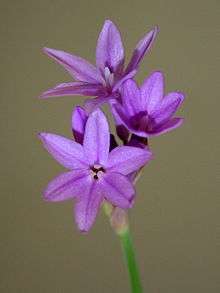Tulbaghia violacea
Tulbaghia violacea, known as society garlic (also known as pink agapanthus,[1] wild garlic, sweet garlic, spring bulbs, or spring flowers[2]) is a species of flowering plant in the family Amaryllidaceae, indigenous to southern Africa (KwaZulu-Natal and Cape Province), and reportedly naturalized in Tanzania and Mexico.[3]
| Tulbaghia violacea | |
|---|---|
.jpg) | |
| Scientific classification | |
| Kingdom: | Plantae |
| Clade: | Tracheophytes |
| Clade: | Angiosperms |
| Clade: | Monocots |
| Order: | Asparagales |
| Family: | Amaryllidaceae |
| Subfamily: | Allioideae |
| Genus: | Tulbaghia |
| Species: | T. violacea |
| Binomial name | |
| Tulbaghia violacea | |

Growing to 60 cm (24 in) tall by 25 cm (10 in) wide, it is a clump-forming perennial with narrow leaves and large clusters of fragrant, violet flowers from midsummer to autumn (fall).[4][5]
Cultivation
When grown as an ornamental, this plant requires some protection from winter frosts. This species[6] and the cultivars ‘Purple Eye’[7] and ‘Silver Lace’, with cream-margined leaves,[8] have all gained the Royal Horticultural Society’s Award of Garden Merit.[9]
Treatment of seeds with a smoke solution has been shown to increase the leaf mass and height of T. violacea seedlings. Seeds exposed to aerosol smoke was also shown to lead to a higher seedling survival percentage.[10]
Edible uses
T. violacea leaves are eaten as a substitute for chives and garlic. In South Africa, Zulu people eat the leaves and flowers as a leaf vegetable like spinach or for seasoning meat and potatoes.[11]
Medicinal uses
Tulbaghia violacea is used locally as a herbal remedy/medicine to treat several ailments.[11]
Due to increasing evidence of its potential as an antifungal agent, large-scale commercialization is anticipated. However, this may make the Tulbaghia genus threatened as it is susceptible to overuse.[11]
Safety and toxicity
Some fatalities and symptoms like gastro-enteritis, abdominal pain, cessation of gastro-intestinal peristalsis, sloughing of the intestinal mucosa, and contraction of the pupils, have been implicated in medication prepared with T. violacea. There has been speculation that T. violacea may cause poisonings but tests on rabbit showed no negative effects. It is possible that reported adverse effects are due to extensive use and/or high dosages of the plant. Adverse effects are generally assumed to be associated with the steroidal saponins and/or the sulphur compounds.[11]
Odor
It may smell like marijuana or skunk to those familiar with either smell.[12] There have been instances in which concerned neighbors have contacted the authorities about the smell of cannabis in the neighborhood only to find out that the culprit was actually lemon verbena or society garlic.[13]
picture
References
- "#793 Tulbaghia violacea". FloriData.
- "Tulbaghia violacea (Society Garlic)". Gardenia.
- Kew World Checklist of Selected Plant Families
- RHS A-Z encyclopedia of garden plants. United Kingdom: Dorling Kindersley. 2008. p. 1136. ISBN 1405332964.
- Harvey, William Henry 1837. Botanical Magazine 64: t. 3555.
- "RHS Plant Selector - Tulbaghia violacea". Retrieved 7 June 2013.
- "RHS Plantfinder - Tulbaghia 'Purple Eye'". Retrieved 29 December 2018.
- "RHS Plantfinder - Tulbaghia violacea 'Silver Lace'". Retrieved 27 December 2018.
- "AGM Plants - Ornamental" (PDF). Royal Horticultural Society. July 2017. p. 103. Retrieved 27 December 2018.
- Sparg; Kulkarni; Light; Van Staden (August 2005). "Improving seedling vigour of indigenous medicinal plants with smoke". Bioresource Technology. 96 (12): 1323–1330. doi:10.1016/j.biortech.2004.11.015.
- Aremu; Van Staden (16 September 2013). "The genus Tulbaghia (Alliaceae)—A review of its ethnobotany, pharmacology, phytochemistry and conservation needs". Journal of Ethnopharmacology. 149 (2): 387–400. doi:10.1016/j.jep.2013.06.046.
- Feix, David (25 Feb 2002). "Re: Society Garlic". hort.net.
- Kuperstein, Adam (18 May 2010). "Mystery Smell in Weston". NBC Miami.
External links
| Wikimedia Commons has media related to Tulbaghia violacea. |
| Wikispecies has information related to Tulbaghia violacea |
- "Tulbaghia violacea - Harv". Plants for a Future.
- "#793 Tulbaghia violacea". FloriData.
- "Society Garlic". Gardening Solutions. University of Florida, Institute of Food and Agricultural Sciences.
- "Tulbaghia violacea". Missouri Botanical Garden.
- "Tulbaghia violacea (Society Garlic)". Gardenia.
- "Tulbaghia violacea". North Carolina Extension Gardener Plant Toolbox. North Carolina State Extension.

